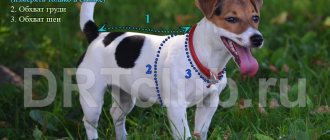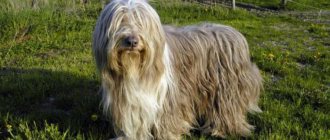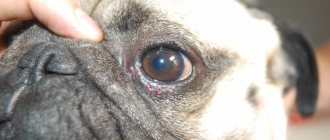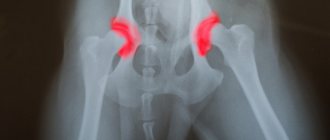What is dermatophytosis?
Dermatophytoses are infectious diseases of keratinized tissues (skin, hair, nails) caused by fungi of the Microsporum, Trichophiton or Epidermophiton species.
In everyday life, all these diseases are called lichen.
If lichen is not noticed in time, this fungal disease can affect the dog for a long time. And not only her. Another insidious thing about deprivation is that it, unlike most other diseases that affect animals, can be transmitted to humans.
In scientific language, such fungal diseases are called zooanthroponotic. Other animals can also become infected with them, not only domestic ones, but also wild ones.
Therefore, the likelihood of your dog becoming infected during a walk is quite high. If there is also a cat living in the house and periodically walking in the yard, it can also bring the fungus, especially since this disease in the first stage can be asymptomatic.
There are several types of dermatophytoses, similar in symptoms:
- ringworm;
- trichophytosis;
- microsporia;
- favus.
All of them are characterized by the appearance on the animal’s skin of areas with signs of flaking, accompanied by loss or brittleness of the hairs of the coat.
The process continues with inflammatory processes on the skin, sometimes with purulent discharge. If nothing is done, these consequences of pathology can develop into a disease that will be very difficult to cure.
The risk group includes individuals with weakened immune systems, those recovering from other diseases, and those who are often in contact with stray animals.
Paradoxically, frequent use of shampoos when washing a dog weakens the protective properties of the skin. This does not mean that you need to stop using shampoos; it is simply advisable to purchase products that are less irritating to the skin.
Symptoms of the disease
Sometimes they are not immediately noticed even by experienced dog breeders. But if you are constantly attentive to your dog and know how the disease begins, you can begin to fight it promptly and effectively.
Changes in fur
At first, the appearance of the dog's hair does not undergo any changes. But the fur begins to fall off. Then the so-called dirty fur effect appears: it becomes dull, and it seems that your pet has become very dirty in something.
At first, some owners think that this is so, but the most thorough water procedures do not change anything. Sometimes it is mistakenly believed that this is a consequence of poor food, atopic dermatitis or an allergic reaction, but home treatment with antihistamines only aggravates the situation - time is wasted, and the fungus continues to develop.
Itching
Sometimes it hardly appears, which makes diagnosis difficult. But most often it develops into a very acute form. The dog scratches the infected areas of the skin literally until it bleeds. In this case, the wool may fall out completely, no longer breaking at the ends.
Baldness
Baldness can occur in small local areas or grow to large sizes. The speed of the process depends on the dog’s immunity and its state of health. It is important to notice its beginning in time.
Baldness usually begins in areas of the muzzle, near the ears and eyes.
Signs of the disease and diagnosis
Poor living and feeding conditions for cats, the presence of injuries on their skin in the form of abrasions, scratches or scratches, uncontrolled walking of pets and their contact with sick individuals are the main causes of infection. Stray infected cats pose a particular danger in the spread of the disease.
The incubation period can last 3-4 weeks. Lesions can be focal or spread throughout the animal's body.
With “ringworm” ( microsporia ), the clinical symptoms of the disease are superficial:
- limited scaly patches;
- crusts form on the skin;
- hair in the affected areas is sparse;
- wool breaks easily.
A specialist can tell you whether this mushroom is dangerous for people after examining the animal.
Attention. In adults, a latent form is often observed, in which there is no massive formation of crusts, scales and hair loss. The disease can only be diagnosed using a fluorescent examination.
Trichophytosis is characterized by:
- formation of areas of inflamed skin;
- flaky scaly surface in places where the pathogen is localized;
- sharply defined lesions with broken hair.
Objective diagnosis
Veterinarians today have at their disposal a special Wood's lamp, the illumination of which reveals the fungus - infected areas under its light turn purple. However, this device does not recognize even half of the causative agents of such diseases; other methods must be used.
A blood test can show the presence of fungus.
It also helps to identify the nature of the disease - if it is allergic in nature, all that remains is to eliminate the allergen.
More detailed analyzes can show another picture: the fungus may be a consequence of coccal disease. In this case, treatment should begin with her.
Older generation veterinarians say that before Wood’s lamp became widespread in our country, they identified harmful fungus with the help of... a toothbrush. It was passed over a suspicious area of the animal's fur, and then shaken off over a Petri dish with a special solution. In the nutrient medium, fungi quickly became active and were detected.
Dermatomycosis in cats and its treatment
The most common causative agents of mycoses in cats are Microsporum canis, Microsporum gypseum, and Trichophyton mentagrophytes.
Routes of infection
A cat can become infected with dermatomycosis by contacting other animals, digging in the ground (this route of infection is inherent in M.gypseum) - fungal spores can maintain their viability outside the animal’s body for up to 18 months.
Depriving forms
Carriage – unfortunately, the presence of dermatophytes on the skin and fur of an animal does not always lead to the development of a clinical picture of the disease. There are often cases when an apparently healthy animal is a carrier of dermatomycosis and infects the pets around it. If you decide to pick up a kitten on the street, the only way to make sure that it is not infected with lichen spores is trichoscopy.
Most often, a clear clinical picture of lichen develops in elderly and weakened animals that have chronic diseases or have suffered trauma.
Duration
In young animals that do not have other diseases, mycosis can resolve spontaneously within several months (2-4). In the case of a complicated history, the duration of the disease can be more than a year.
Clinical picture
Since dermatophyte spores infect the hair follicle and destroy the entire length of hair, the most typical sign of lichen is the appearance of areas of baldness (usually round), which may have a flaky, crusty, hyperemic surface. In cats, a typical location for lichen is the ears. Less commonly, mycosis in cats is manifested by the appearance of rashes, crusts, etc.
Diagnostics
To make a correct diagnosis, trichoscopy is required - examining the hair of a sick animal under a microscope. If the pathogen is not identified, or a more precise identification of the fungus is required, a bacteriological examination of the affected area (culture) is carried out.
The widely used Wood's lamp examination (it uses a special spectrum of light radiation) cannot be used to diagnose or exclude mycosis in a cat, since the characteristic glow of the fur occurs only when affected by fungi of the genus Microsporum. Wood's lamp can only be used to monitor therapeutic measures.
Treatment
Treatment of an animal with extensive skin lesions by dermatophytes is quite complex and lengthy. To completely get rid of the pathogen, it is necessary not only to use etiotropic antifungal drugs internally and externally, but also to carry out regular disinfection of the environment. In addition, all animals that come into contact with a cat affected by lichen need treatment.
If the cat is a carrier or has single lesions, the sick cat only needs external treatments. The criterion for recovery is obtaining two negative bacteriological test results with an interval of one month.
You should not vaccinate an infected animal against ringworm, or use immunostimulating agents - clinical studies have not proven the effectiveness of these measures for ringworm in cats. The spontaneous recovery of the animal observed in some cases has nothing to do with vaccination, but is characteristic of dermatophytosis in animals.
On this and other issues you can get advice at the Zaporozhye Center of Veterinary Medicine.
How to treat?
As a rule, treating lichen at home is quite possible, but under regular medical supervision. In addition, the apartment must be constantly wet cleaned and cleaned with a vacuum cleaner - the fungus can spread to humans.
It is advisable to wear medical gloves when contacting a sick pet.
Local therapy
Used in case of local lesions. If the fungal lesions have not yet grown very much, you can use ointments that are used to treat fungal diseases in humans.
This is, for example, clotrimazole. In more complex cases, solutions and shampoos are used (for example, the same “human” Nizoral).
In addition, it is recommended to use:
- lime sulfur solution;
- miconazole solution;
- povidine iodide;
- rinsing solutions containing chlorhexidine.
The dog's ears are treated separately using cotton swabs.
Systemic antifungal drugs
They are used in especially severe cases when large areas of the body are affected. The wool is completely shorn and burned. These drugs include fulcin, gricine and biogrisin . They have a wide spectrum of action and increased efficiency; they are given to the animal along with food, preferably fatty.
But these drugs have many side effects - they often cause vomiting. As a rule, treatment lasts 7-12 days.
Diagnosis of lichen in dogs
The diagnosis is made based on a series of studies. After examination, a diagnosis is usually made using a Wood's lamp. When exposed to the light of this lamp, the affected areas glow with a yellowish-green glow. But it is worth noting that only 50% of cases of M. canis lesions give such a glow.
In addition, if the lamp was not heated, or the animal’s skin was previously treated with iodine, then there will be no glow either. Some bacterial infections and topical ointments also produce a glow. Therefore, the next step towards diagnosis is a microscopic examination of the hair to detect fungal spores.
Prevention
Unfortunately, it is impossible to completely protect your pet from fungal diseases. But the risk can be reduced, for example, by reducing the possibility of contact with stray animals and their habitats.
The fungus can remain active for a long time in the area where a sick animal is lying. Regular preventative visits to the veterinarian won't hurt either.
As we can see, modern veterinary medicine has effective means to combat fungal diseases. But it is better not to resort to long-term treatment if the disease is noticed in time. So be more attentive to your pet.
Additionally, watch a short video about the diagnosis and treatment of dermatophytosis (lichen) in dogs:
Symptoms and treatment of ringworm in cats
When carrying out long-term immunosuppressive therapy, with chronic skin diseases, allergies, the animal should be regularly examined for concomitant infections.
Dermatomycoses pose a danger to people interacting with affected animals. The most susceptible to the disease are people with immunodeficiencies of various origins, skin lesions and diseases, as well as children. Cats, compared to dogs, are more often sources of infection in humans.
At the first signs of the disease, you should limit contact with the animal as much as possible, it is advisable to isolate it in a separate room, keep it away from children, carefully observe hygiene measures, change clothes, wash your hands, boil clothes. Disinfection is conveniently carried out using bactericidal quartz lamps (30 minutes per irradiation zone). For the same purpose, you can use bleach and formaldehyde.
Balanced feeding, control of allergic diseases, and proper coat care also guarantee protection against fungal diseases.
Back to section
Dermatomycosis (lichen versicolor) is a fungal disease (dermatophytosis) caused by the invasion of fungi in the surface layers of the skin.










